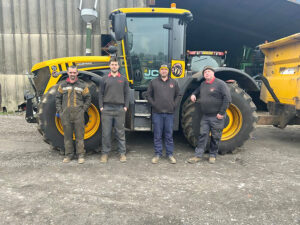Quality and efficiency key to farming/contracting business
16th March 2023
A South Yorkshire family contracting business says investments in quality machinery has been integral to its success. Farmers Guide finds out more.

Steve Watkins (far right) pictured with (l-r): full time staff member James Taylor, and Steve’s cousins James and Tom Watkins.
The Watkins family, who built up their contracting business over the past 40 years, talk us through the machinery they run to deliver efficient arable and grassland operations in the 30-mile radius of their home farm, near Rotherham.
Steve Watkins, alongside his two uncles and two cousins, are the third generation at Hall Farm. The family run T E Watkins and Sons contracting business, alongside farming their 1,500-acre arable farm, carrying out a range of services from grass, maize and whole crop silaging, to drilling, combining, baling and spraying. Its fleet includes five JCB fastrac, a Krone forager, Claas Lexion combine, Krone BiG Pack and an Amazone Pantera self-propelled sprayer.
High quality bales
“We made the switch last year to a Krone BiG Pack 1270 and we’ve been more than happy with the move. Although the baler was slightly more expensive than other options we looked at, we were won over by the quality of the machine and back up of spare parts available at crucial times of the year,” says Mr Watkins.
Their local dealer, Moore Farm Services is located just a few miles away from the farm and provides consistent and reliable support all year round.
“The baler performed fantastically in its first season, having done around 11,000 bales already. It typically produces great bale weights even with dry straw. It can be exceptionally hard to get a good bale weight when it’s so dry because the straw is harder to compress, but this hasn’t been an issue. This means when we’re selling our straw, we can get more tonnage onto a lorry which translates into lower haulage costs. This is important for our margins,” he says.
Efficiency in all conditions
Having run foragers from another brand for 20 years and generally being very pleased by how the machines performed, the business was approached in 2016 by their local dealer to trial a Krone forager.
After a further two demonstrations in proceeding years, the family bought BiG X in 2019. They are now on their second BiG X, with the family being impressed with its ability to harvest both grass and maize for anaerobic digestors and livestock feed.
“Our workload significantly increased in 2014, with an increase in silaging for AD plants and it’s now the biggest proportion of our business, the maize we cut is feeding three digestors,” Mr Watkins says. “We were amazed by how the demo performed in terms of chop quality compared to our previous forager, particularly for the requirements for AD maize, where the maize is cut into much shorter pieces.”
Mr Watkins explains that they were ‘sat on a knife edge’ when it came to deciding between having another forager from their previous brand or making the move to Krone – the deciding factor became the ability to easily swap out the chopping cylinder.
“This was hugely important to us, so we could accommodate our full range of customers,” he says. “Livestock customers often prefer their forage much longer so the animal can chew it for longer, which requires fewer blades and therefore, fewer chops per second.
“We’d previously had a 24-blade cylinder, which wasn’t cutting forage to the quality needed for AD; to rectify this, we were looking at buying a 36-blade drum and removing half the blades when chopping for livestock. This was going to be hugely time-consuming, which in the height of the season is something we wanted to avoid.
“Krone offered two separate chopping cylinders, one with 20 blades and one with 36 blades. Both cylinders use the same type of blade as each other, making it easier to manage spare parts.”
When upgrading to their second BiG X in 2021, there were a number of details that were attractive to the contractors, including a wider crop channel that helped improve efficiency in the smaller 580 machine.
“The 580 is more than capable of handling a 12-row header, with the efficiency of the six feed rollers – it takes in the quantity of maize with ease. It’s not about speed for us,” he says, “I’m a big believer in using the machine’s power to chop thoroughly rather than using its power to move quickly, to maximise efficiency.”
